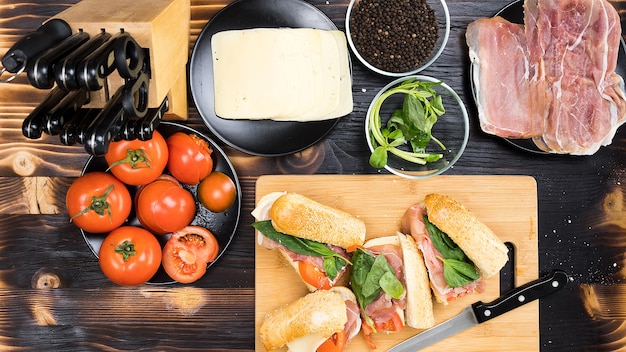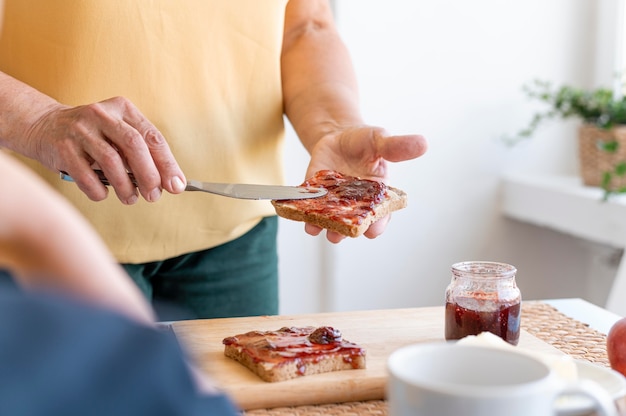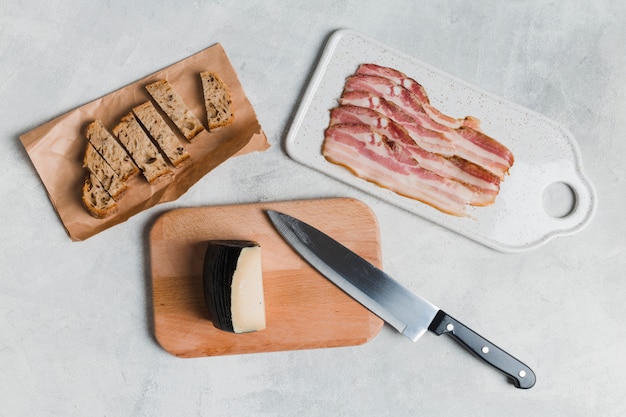Ah, bacon. Just the word conjures up images of golden-brown strips, crackling with deliciousness, and releasing that irresistible aroma that fills your kitchen with pure joy. We're not talking about any old bacon, mind you. We're talking about perfectly crispy bacon – the kind that shatters in your mouth, the kind that leaves a satisfying sheen of grease on your plate, the kind that makes you question if it's even food it's so good.
Now, I know what you're thinking: "Bacon? It's just bacon, right? Toss it in a pan, cook it up, and you're done." But, my friend, you're in for a treat. This isn't just a recipe; it's a guide, a manual, a bible to achieving bacon nirvana. We're going to dive into the nitty-gritty, the dos and don'ts, the secrets to making your bacon the absolute best it can be.
Ready to embark on a journey of bacon perfection? This is going to be epic.
(Part 1) choosing the right bacon

First things first, you need to choose your weapon, your raw material, your bacon. This isn't just a trip to the supermarket; this is a mission. Don't settle for the cheapest option. You're aiming for quality. A good quality bacon is the foundation of your crispy bacon masterpiece.
types of bacon
- streaky bacon: This is the classic, the one you probably picture when you think "bacon." It's thick-cut, with lots of fat marbling, and delivers that quintessential crispy texture. You know, the kind that breaks into satisfying shards when you bite into it. This is the bacon for those who truly appreciate the art of the crispy crunch.
- back bacon: This is a British favourite. It's leaner than streaky bacon, with a more delicate flavour. It tends to be less crispy, but it's still a delicious option, especially if you prefer a less intense bacon experience.
- smoked bacon: This bacon is cured with smoke, giving it a distinctive flavour. It's usually thicker than streaky bacon and can be a little more challenging to cook perfectly, but the added smoky depth is well worth the effort.
Thickness
The thickness of your bacon will affect how long it takes to cook and how crispy it gets. If you're looking for super-crispy bacon, go for a thicker cut. The extra fat will render out, leaving behind a wonderfully crispy, almost caramelized bacon. If you prefer a more tender bacon, a thinner cut will cook faster and be less likely to dry out. It's all about finding the right balance for your taste buds.
Fat Content
The fat content of your bacon is another important factor. A higher fat content will result in a crispier bacon, but it will also be more greasy. A lower fat content will result in a leaner bacon, but it may be less flavorful. Personally, I'm a fan of thick-cut, high-fat bacon. It's the perfect balance of crispy texture and rich flavour. The fat renders out, creating that satisfying crackle, and the richness of the fat adds a depth of flavor that's truly unbeatable.
(Part 2) The Tools of the Trade

Okay, you've got your bacon, now you need the right tools to get the job done. Let's talk equipment. This isn't just about finding a fancy pan - it's about finding the perfect tools for the job.
The Pan
A good quality pan is essential for crispy bacon. You want something heavy-bottomed and with a large surface area to allow the bacon to cook evenly. I recommend a cast iron skillet. Cast iron heats up beautifully and distributes heat evenly, ensuring your bacon cooks evenly without burning. A good cast iron skillet is an investment, but it will last you a lifetime, becoming a seasoned friend in your kitchen.
You can also use a stainless steel or non-stick skillet. Just make sure it's oven-safe, as you'll need to finish the bacon off in the oven for optimal crispiness.
The Oven
The oven plays a vital role in the crispy bacon game. You'll need it to finish off the bacon, and it will help to ensure that it's cooked evenly and doesn't burn. Ideally, you want to use a conventional oven. If you've got a fan-forced oven, make sure to adjust the temperature accordingly, as the fan can speed up the cooking process and lead to uneven results.
Other Tools
You'll also need a few other tools for your crispy bacon mission. A pair of tongs will be essential for flipping the bacon and transferring it to the oven. You don't want to use a spatula, as it can damage the bacon. A paper towel-lined plate will be used for draining the bacon and removing excess grease. You can also use a wire rack to let the bacon cool and drain, allowing for maximum crispiness.
(Part 3) The Art of the Cook

Now that we've got the right ingredients and the right tools, let's get down to the actual cooking. This is where the real magic happens. But remember, this isn't a race. It's a process. Take your time, enjoy the process, and you'll be rewarded with a truly delicious result.
The Pan
Start by preheating your pan over medium heat. You want the pan to be hot enough to render the fat from the bacon, but not so hot that it burns the bacon. If you hear a gentle sizzle when you add a drop of water to the pan, you're good to go.
The Bacon
Once your pan is hot, add the bacon in a single layer. Don't overcrowd the pan. You want the bacon to have space to cook evenly. If you've got a lot of bacon, cook it in batches. This will ensure that each piece gets the proper amount of time to cook and become gloriously crispy.
The Cooking Process
Let the bacon cook undisturbed for a few minutes. You want the bottom side to get nice and crispy. Don't flip the bacon too soon, or it will stick to the pan. You'll see the fat start to render out and the bacon will begin to curl at the edges, a sign that it's getting crispy.
Once the bottom is crispy, flip the bacon and cook for another few minutes on the other side. You'll notice the fat sizzling more intensely as the bacon releases its flavorful juices. Keep an eye on the bacon, and adjust the heat if necessary.
Once the bacon is mostly cooked, you can transfer it to a preheated oven. This is where the magic really happens. You want to cook the bacon in the oven until it's perfectly crispy. The oven will help to evenly cook the bacon and ensure it doesn't burn.
The exact cooking time will vary depending on the thickness of the bacon and the temperature of your oven. But, you're aiming for that golden, crispy perfection. You'll know it when you see it. The bacon will have a beautiful golden sheen and will be firm and springy to the touch. It should be a joy to look at, and even more of a joy to eat.
(Part 4) The Essence of Crispness
It's time to delve into the heart of the matter - crispness. This isn't just a culinary term; it's an art form. Achieving that perfect level of crispness requires precision, patience, and an intimate understanding of your bacon. It's like mastering a delicate dance between heat and time. But don't worry, you've got this!
The Crucial Factors
There are a few key factors that influence the crispiness of your bacon. First, the quality of your bacon plays a significant role. As mentioned before, a higher fat content will generally lead to a crispier result. The fat renders out, creating that satisfying crackle and leaving behind a crispy, flavorful bacon. Secondly, the heat of your pan is essential. If your pan isn't hot enough, the bacon will cook slowly and won't get crispy. You need that intense heat to quickly render the fat and create that desirable crunch. And finally, the cooking time is vital. You need to cook the bacon long enough to render the fat and achieve that satisfying crunch.
The Magic of Patience
Remember, patience is key. Don't rush the process. Let the bacon cook slowly and evenly. You want to give the fat time to render and the bacon to crisp up. If you're impatient and flip the bacon too soon, you'll end up with soggy bacon.
If you're not sure if the bacon is crispy enough, give it a little poke with your tongs. It should be firm and springy to the touch. If it's still floppy, keep cooking. You can also use a spatula to lift a piece of bacon and check if it's crispy on the underside. You want it to be golden brown and have a nice, tight curl.
(Part 5) Avoiding the Pitfalls
Now, let's address the elephant in the room - the things that could derail your crispy bacon mission. There are some common mistakes that people make when cooking bacon, mistakes that could result in soggy bacon, burnt bacon, or just generally disappointing bacon. But don't worry, we've got your back. Here's how to avoid those pitfalls.
Overcrowding the Pan
One of the most common mistakes is overcrowding the pan. If you add too much bacon to the pan, it won't cook evenly and will steam rather than crisp up. The bacon will be soggy and lack that wonderful crunch. You want to make sure there is enough space between the slices of bacon to allow for proper air circulation and fat rendering. Cook in batches if you need to!
Not Cooking Long Enough
Another common mistake is not cooking the bacon long enough. If you take the bacon out of the pan too soon, it won't be crispy. You need to cook it until the fat has rendered and the bacon is nice and firm.
Using Too High of a Heat
If you use too high of a heat, the bacon will burn before it has a chance to crisp up. You'll end up with burnt bacon, which is not only unappetizing but can also be bitter. Start with medium heat and adjust as needed. You want to hear a gentle sizzle, not a roaring fire.
Flipping the Bacon Too Soon
If you flip the bacon too soon, it will stick to the pan. Let the bacon cook undisturbed for a few minutes on the first side before flipping it. Allow the bacon to release from the pan on its own, and you'll avoid a sticky mess.
(Part 6) The Art of the Finish
We're nearing the grand finale, the finishing touches. Think of this as your chance to elevate your bacon from delicious to downright divine. It's all about the small details.
Draining the Excess Grease
Once your bacon is cooked, you need to drain the excess grease. You can do this by transferring the bacon to a paper towel-lined plate. This will help to absorb some of the grease and prevent the bacon from becoming soggy.
You can also use a slotted spoon to remove the bacon from the pan, allowing the grease to drain away.
Seasoning
Now, this is where you can really get creative. You can season your bacon with salt and pepper, or you can get fancy and add other spices like garlic powder, onion powder, paprika, or even chili powder. A pinch of smoked paprika can add a beautiful smoky depth to your bacon, for example.
You can also use a maple syrup glaze or a brown sugar glaze for a sweet and savory flavour. The possibilities are endless! Experiment with different seasonings and find what you enjoy the most.
(Part 7) Serving and Storing
The bacon is cooked, the grease is drained, and the seasonings are applied. Now, it's time to enjoy your crispy bacon masterpiece. You can serve it hot, or you can let it cool and store it for later.
Serving
You can serve your bacon with a variety of dishes, from eggs and pancakes to sandwiches and salads. I personally love it with a simple green salad. The crispy bacon adds a salty, savory crunch that contrasts beautifully with the freshness of the greens.
You can also use your crispy bacon in other recipes, like a bacon and cheddar quiche or a bacon and mushroom pasta dish. It's a versatile ingredient that can elevate any dish to new heights of deliciousness.
Storing
If you have leftover bacon, you can store it in an airtight container in the refrigerator for up to 3 days.
You can also freeze your bacon for longer storage. To freeze bacon, wrap it tightly in plastic wrap or aluminum foil and place it in a freezer bag. frozen bacon will keep for up to 2 months. When you're ready to use it, you can thaw it in the refrigerator overnight or defrost it in the microwave.
(Part 8) FAQs
You've read about the secrets of crispy bacon, but you're still wondering about some details? No worries, here are the answers to some of the most common questions about crispy bacon:
1. What if I don’t have a cast iron skillet?
No worries! Any heavy-bottomed pan will do. Just make sure it's oven-safe so you can finish cooking the bacon in the oven.
2. How do I make sure my bacon is crispy on both sides?
The key is to cook it long enough. Don't be afraid to cook it for a little longer than you think you need to. If you're unsure, give it a little poke with your tongs. If it's still floppy, keep cooking!
3. Can I cook bacon in the oven only?
Yes, you can. Preheat your oven to 400 degrees Fahrenheit (200 degrees Celsius) and place the bacon on a baking sheet lined with parchment paper. Cook for 15-20 minutes, flipping halfway through, until crispy. This is a great option if you don't have a lot of stovetop space or want to cook a large batch of bacon.
4. How do I get rid of the excess grease?
Once the bacon is cooked, transfer it to a paper towel-lined plate. The paper towels will absorb some of the grease. You can also use a slotted spoon to remove the bacon from the pan, allowing the grease to drain away. You can also use a wire rack to allow the bacon to drain and crisp further.
5. What if I don’t have an oven?
You can still achieve crispy bacon without an oven. Cook the bacon in the pan over medium heat until it is mostly cooked. Then, drain the grease and transfer the bacon to a baking sheet. Use a hairdryer to blast the bacon with hot air. This will help to dry out the bacon and make it crispy.
You can also use a microwave to make crispy bacon. Place the bacon on a microwave-safe plate lined with paper towels. Microwave on high for 2-3 minutes, flipping halfway through, until crispy. This method may not achieve the same level of crispness as cooking in a pan or oven, but it's a quick and easy option.
Now, go forth and conquer the world of crispy bacon! You've got this.
Everyone is watching

Prime Rib Roast Cooking Time Chart: Per Pound Guide
Cooking TipsPrime rib roast. Just the name conjures images of lavish dinners, crackling fires, and hearty laughter. It’s ...

How Long to Bake Potatoes in the Oven (Perfect Every Time)
Cooking TipsBaked potatoes are a staple in my kitchen. They're incredibly versatile, delicious, and surprisingly easy to m...

Perfect Rice Every Time: The Ultimate Guide to Cooking Rice
Cooking TipsAs a self-proclaimed foodie, I've always been a bit obsessed with rice. It's the foundation of countless cuisi...

The Ultimate Guide to Cooking Asparagus: Tips, Techniques, and Recipes
Cooking TipsAsparagus. The mere mention of this spring delicacy conjures up images of vibrant green spears, crisp and burs...

Ultimate Guide to Cooking the Perfect Thanksgiving Turkey
Cooking TipsThanksgiving. Just the word conjures up images of overflowing tables laden with delicious food, the scent of r...
